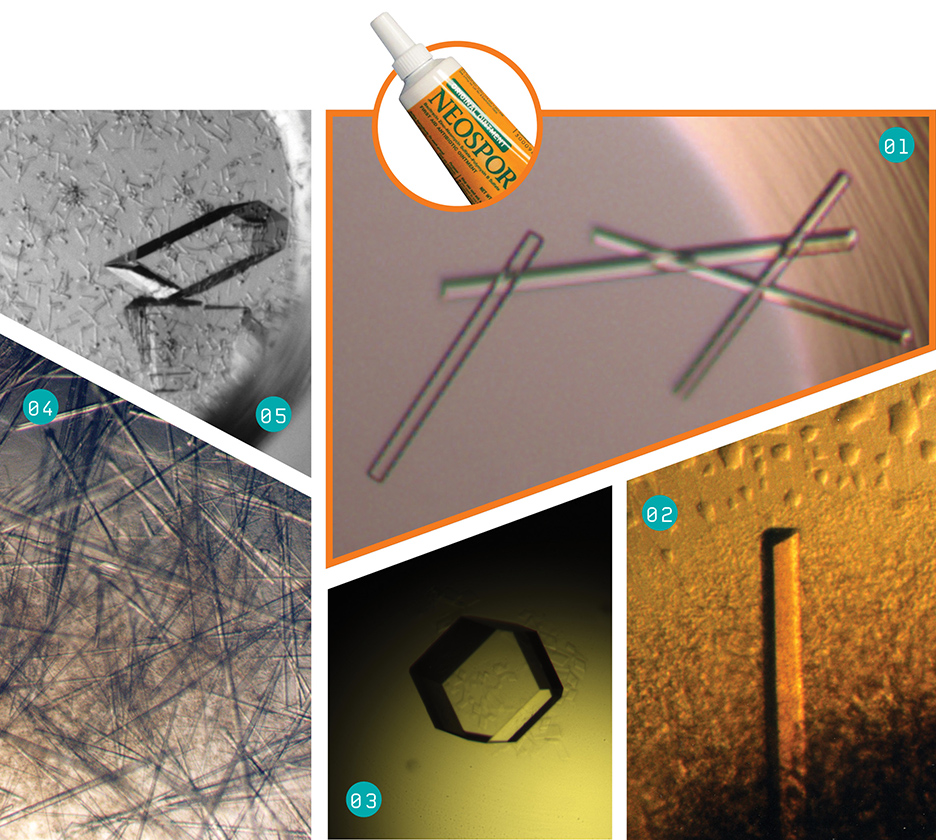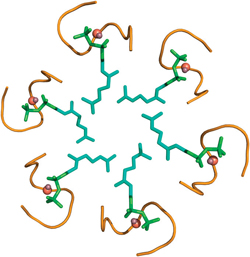
_Patrick Loll
Loll is a professor in the Department of Biochemistry and Molecular Biology in Drexel’s College of Medicine.
A couple of years ago, Patrick Loll and his students solved a nearly 70-year-old mystery. Using crystallography, they became the first researchers to understand precisely how bacitracin, a household antibiotic derived from the bacterium Bacillus subtilis var Tracy and first approved in 1948, combats infection in the body.
Crystallography — the study of how atoms in a material are arranged — involves the creation of three-dimensional models of molecules. The models allow scientists to see how the molecules are structured, in order to better understand how they function. In the case of antibiotics such as bacitracin, the structural models reveal how these molecules latch onto and interact with their bacterial cell targets.

Models_for_Meds
Loll estimates that he has grown thousands of crystals, including those displayed at above.
01. Bacitracin is a natural-product antibiotic best known as a component of “triple antibiotic” ointments.
02. This is a crystal of the COX1 enzyme, which is the target of aspirin, ibuprofen, naproxen and other NSAIDs.
03. Ramoplanin is a new investigational antibiotic that is being tested as a treatment for C. difficile infections.
04. Porin is a protein from the outer membrane of the bacterium E. coli, where it mediates the uptake of various nutrients and drugs.
05. PfeA is a protein from the outer membrane of Pseudomonas aeruginosa, an opportunistic pathogen.

crystals_of_vancomycin
The rise of bacterial resistance to vancomycin (often considered the antibiotic of last resort) has motivated researchers to find alternatives. Through crystallography, Drexel researchers seek to understand how vancomycin recognizes its target, with the goal of exploiting this information to design new, more effective variants.
A_How-To
The process of growing crystals is laborious and famously prone to failure.
01. Researchers first must generate large quantities of the molecule of interest. This step can require many months of trial and error, and in some cases it simply fails outright.
02. Researchers then purify away other kinds of molecules, so that only the desired molecule remains in the test tube.
03. In the crystallization step, researchers experiment with different reagents in hopes of finding an additive that coaxes the delicate molecules into assembling into a nicely ordered 3-D lattice. The crystallization step is very sensitive to outside variables. Many projects fail at this stage, and even the ones that work usually require thousands of experiments to hone in on the right set of conditions for good crystallization
04. Researchers then shoot a beam of X-rays at the crystal, which scatters the X-rays in different directions. High-tech detectors capture the scattered radiation and this information is fed into a series of calculations that ultimately yields an image of the molecule.

Bacitracin’s_Secret
Loll and his collaborators learned that Bacitracin works by targeting a lipid that harmful bacteria use to shuttle essential building blocks to their cell walls. Bacitracin is able to grab onto the lipid and prevent it from delivering materials that the bacterial cell needs to survive, and it dies.
By elucidating the structure of bacitracin, Loll, his student Nicoleta Economou, and their Drexel collaborator Simon Cocklin were able to determine that the antibiotic works by targeting a lipid that harmful bacteria use to shuttle essential building blocks to their cell walls. Bacitracin is able to grab onto the lipid in a way no one had predicted; this interaction prevents the lipid from delivering materials that the cell needs, thereby killing the bacteria.
Their finding was published in the Proceedings of the National Academy of Sciences of the United States of America.
